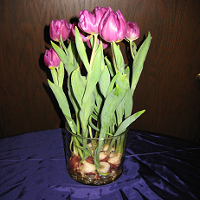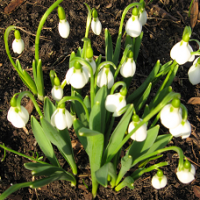It’s mid-March and we’ve had our first real spring day! Even the mailman commented that you can tell spring is here because Barb is in her garden. I suppose there are worse things to be known for than that.
The land—dormant and under the shroud of snow—suddenly reveals its life with the first of the warm days. I am reminded of Isaiah 35:1-2: “The desert and the parched land will be glad; the wilderness will rejoice and blossom. Like the crocus, it will burst into bloom; it will rejoice greatly and shout for joy. The glory of Lebanon will be given to it, the splendor of Carmel and Sharon; they will see the glory of the LORD, the splendor of our God.”
 I think there’s something of the splendor of God in every emerging sprout, the jiggle of the earthworm, and the singing of the cardinals. I love spring.
I think there’s something of the splendor of God in every emerging sprout, the jiggle of the earthworm, and the singing of the cardinals. I love spring.
Remember my tulips that I forced? They’re in full bloom now. I tucked some forsythia into some the vases to have a beautiful contrast of colors. If you were to roll up a rainbow into a wheel, it’s what designers will call a color wheel. It’s a useful tool for understanding how colors work together. Purple and yellow are highly contrastive; opposites on the color wheel and therefore are your eye’s most natural color complements. Anytime you use opposite colors, they will highlight each other.
Rose cones come off now. With a careful eye to the weather forecast and a string of less frosty days ahead, I remove the rose cones before the buds “break” from within the canes. If roses stay too long under the cones, the buds will break into tender leaf shoots and will be more susceptible to frost. I still have a mound of mulch over the graft union (the place where the lovely variety was grafted onto the root stock). I will be removing that soon too.
I’ve begun carefully raking the late falling willow leaves that blow into my flower beds, pruning away winter damage from some shrubs that don’t mind a haircut in the spring before their leaves emerge, and pulling garden grass which comes out easily when the ground is soft and moist. It’s also easy to distinguish invading grass from look-alikes such as grape hyacinth and scilla foliage because of the way the roots are. I like inspecting my plants while I do yard work so that I can develop a plan for getting ahead of (and preventing) problems and for preparing my yard for planting.
 The snow isn’t completely gone from my yard, but my early spring bulbs (which are late this year because of snow cover) are coming up. Snow crocus, snowdrops, winter aconite are among my favorites for cheering the heart. Soon, the chinodoxa and daffodils will be blooming in warmer microclimates in my yard. Not all the daffodils will flower outside though–some will come indoors to bloom.
The snow isn’t completely gone from my yard, but my early spring bulbs (which are late this year because of snow cover) are coming up. Snow crocus, snowdrops, winter aconite are among my favorites for cheering the heart. Soon, the chinodoxa and daffodils will be blooming in warmer microclimates in my yard. Not all the daffodils will flower outside though–some will come indoors to bloom.
And of course, pansies. I didn’t want to tell the mailman, but I already have a few that I overwintered in my garage that are on my back deck warming themselves and readying to spring into action.
4 Comments
hey barb, question. how do you know what to tackle when. i usually just do what i see first. gary
Hi Gary, thanks for writing! I have a couple of different ways I know what to tackle.
First, prior experience with my yard. I know what I have and have learned what each thing needs. For people in a new home with plantings, I usually suggest waiting through the first spring for planting so they can see if any bulbs are coming up…and to take some time to do a “site survey” of what trees and shrubs and light/water conditions exist. This will form the template for what you will do each year.
Second, I’m doing yard clean-up (raking leaves, pulling weeds and grass that have invaded the garden, adding limestone screenings to fill in a pathway, applying mulch to the gardens, pruning winter damage, inspecting trellises, building structures, and planning what to buy/shopping for pots, etc). I use my clean-up time to plan and design in my mind so that I can do things a bit differently each year.
As I clean, I’m also inspecting the plants. I make a regular habit of this since I discovered a tiny bit of scale (insect) on one shrub rose and on my redbud tree. By catching things early, a less severe treatment for solving insects and diseases can replace more drastic summer measures.
Third, I write out my design/plan and being by starting seeds using my “countdown to planting calendar” which is my regular wall calendar with weeks listed to the last frost date for my area. In the US, we have the USDA zone charts. In your country, they will have weather histories of when the last frost typically is. For my area of Chicagoland, it’s May 15th.
And finally, my spring is not complete without planting pots which can give nice floral color, yet can come into the garage or under frost cloth as the season is still unpredictable.
Hope this helps to give you some ideas.
hey barb, it’s gary again. reading your answer, what’s scale (insect)? and where do i get a usda zone chart? gary
Hi Gary,
Scale is a type of insect that damages trees, shrubs and other ornamental plants by adhering itself usually to branches and stems. They can be (1) armored scale, (2) soft scale, or (3) technically mealybugs are scales too. Often the armored types of scales are harder to kill in that they resemble a half of a mussel shell (although sometimes they are more rounded in appearance). The scale’s armored shell protects the insect beneath.
Scale are harder to notice in small populations, but beneath the hard shell is a sucking insect that can damage your plant in two ways. First, it robs the plants of some of the food that plants are making to sustain themselves. Second, however, is that the insects secrete honeydew which allows secondary infections to flourish. Sticky honeydew is an ideal breeding ground for sooty mold and powdery mildew which can damage the plant’s ability to make food. Oftentimes, the secondary infection is your first indication that scale or other sucking insects are present (aphids, whiteflies, etc).
Prime targets for scale are conifers, roses, magnolias, lilac, ash, cotoneaster, and willow. Knowing the life cycle will help you to decide when to use which control measures.
And the National Arboretum has an interactive USDA hardiness zone map here:
http://www.usna.usda.gov/Hardzone/ushzmap.html